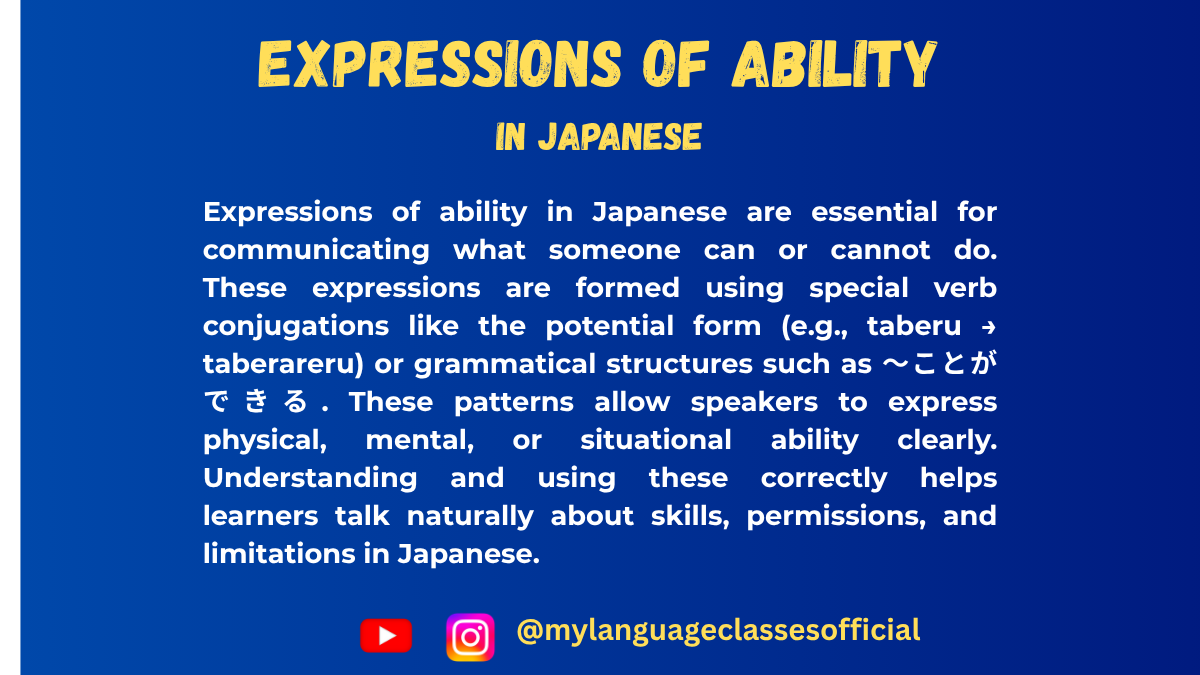Your cart is currently empty!
Tag: expressing ability
-

Understanding Ability in Japanese | My Language Classes
Mastering the Expressions of Ability in Japanese
When learning Japanese, expressing ability—your capacity to “do” something—is a crucial skill. In this post, we’ll delve into one of the most common ways to express “can” in Japanese: using ことができる (koto ga dekiru). Along the way, we’ll also explore the potential form of verbs, explaining what it is, how it’s formed, and when to use it. Let’s get started!
Understanding ことができる
The phrase ことができる translates roughly to “can do” or “be able to do.” It’s a versatile structure that allows you to express ability in relation to a wide range of actions. Here’s a breakdown of its components:
- こと: A nominalizer that turns verbs into nouns. For instance, “to speak” (話す, hanasu) becomes “the act of speaking” (話すこと, hanasu koto).
- が: The particle marking the subject of the ability.
- できる: The verb meaning “can do” or “to be able to do.”
Basic Formula:
Verb (Dictionary Form) + ことができる
Examples:
- 日本語を話すことができる
(Nihongo o hanasu koto ga dekiru)
“I can speak Japanese.” - ピアノを弾くことができる
(Piano o hiku koto ga dekiru)
“I can play the piano.” - 友達と旅行することができる
(Tomodachi to ryokou suru koto ga dekiru)
“I can travel with my friends.”
Using できる as a Standalone Verb
Did you notice that できる itself can also stand alone? It translates simply as “can do” and is often paired with a noun:
- テニスができる
(Tenisu ga dekiru)
“I can play tennis.” - 宿題ができる
(Shukudai ga dekiru)
“I can do homework.”
This usage avoids the ことが entirely, but the meaning remains similar.
What is the Potential Form?
The potential form of a verb is another way to express “can” or “ability to do something” in Japanese. Unlike ことができる, the potential form is built directly into the verb itself. It’s widely used in casual speech due to its simplicity and brevity.
When to Use the Potential Form
The potential form is ideal for situations where:
- Informality is key: It’s more conversational than ことができる.
- Directness is preferred: Instead of a multi-word structure, the potential form is compact and to the point.
How to Form the Potential Form
The way you form the potential form depends on the type of verb:
1. Group 1 Verbs (U-verbs)
For U-verbs, change the final -u sound of the dictionary form to its corresponding -eru sound.
Example:
- 話す (hanasu, “to speak”) → 話せる (hanaseru, “can speak”)
- 書く (kaku, “to write”) → 書ける (kakeru, “can write”)
- 泳ぐ (oyogu, “to swim”) → 泳げる (oyogeru, “can swim”)
2. Group 2 Verbs (Ru-verbs)
For Ru-verbs, simply replace the final -ru with -rareru.
Example:
- 食べる (taberu, “to eat”) → 食べられる (taberareru, “can eat”)
- 見る (miru, “to see”) → 見られる (mirareru, “can see”)
3. Irregular Verbs
There are only two irregular verbs to remember:
- する (“to do”) → できる (“can do”)
- 来る (kuru, “to come”) → 来られる (korareru, “can come”)
Examples of the Potential Form:
- 日本語が話せる
(Nihongo ga hanaseru)
“I can speak Japanese.” - ピアノが弾ける
(Piano ga hikeru)
“I can play the piano.” - 友達と旅行できる
(Tomodachi to ryokou dekiru)
“I can travel with my friends.”
Potential Form vs. ことができる
While both methods express ability, they have distinct nuances:
- ことができる: More formal and suitable for writing or polite contexts.
- Example: 日本語を話すことができる
- Potential Form: Shorter and more conversational.
- Example: 日本語が話せる
The Negative Forms
For both ことができる and the potential form, negation is straightforward:
- ことができない: “Cannot do.”
- Example: 日本語を話すことができない
- Potential form (negative): Replace the final -eru or -rareru with -enai or -rarenai.
- Example: 日本語が話せない
Politeness Levels
Japanese offers ways to adjust politeness. Here’s how to modify each form:
- ことができます: Polite version of ことができる.
- Potential Form (Polite): Add -ます to the potential form.
- Example: 話せます (hanasemasu, “can speak”).
Practice Makes Perfect
Let’s end with some practice sentences. Try translating these into Japanese:
- “I can read kanji.”
- “I cannot eat sushi.”
- “I can go to Japan next year.”
(Answers: 1. 漢字を読むことができる / 漢字が読める, 2. 寿司を食べることができない / 寿司が食べられない, 3. 来年日本に行くことができる / 来年日本に行ける)
Final Thoughts
Understanding how to use ことができる and the potential form unlocks a world of possibilities for expressing your abilities in Japanese. Whether you’re aiming for formal precision or casual brevity, practicing these structures will help you sound more natural and confident.
Have questions or want to share your examples? Comment below! 😊
If you enjoyed this lesson, be sure to check out more posts like this on my blog at My Language Classes. Don’t forget to subscribe my YouTube channel and follow me on Instagram for the latest language learning tips and lessons. Leave a comment below to share your thoughts, or ask any questions you have about nouns.
Happy learning! 😊
